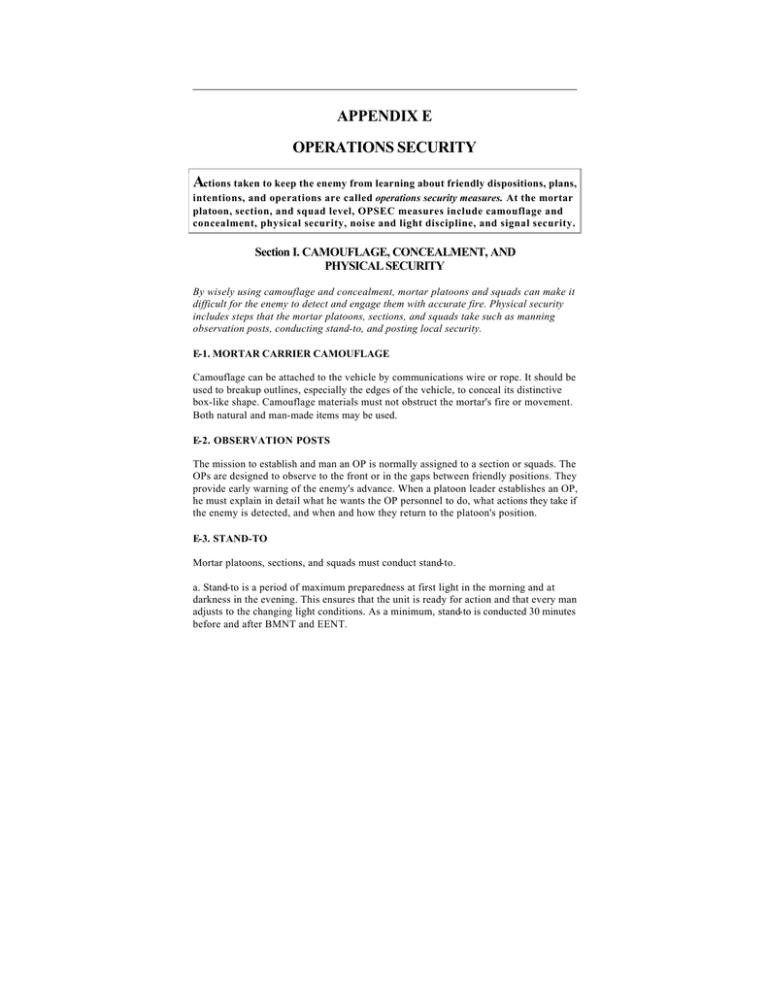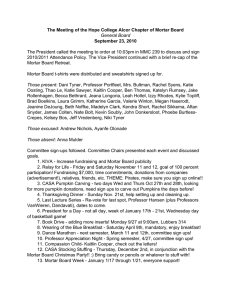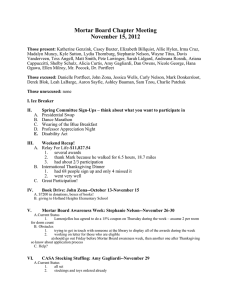APPENDIX E OPERATIONS SECURITY A
advertisement

APPENDIX E OPERATIONS SECURITY Actions taken to keep the enemy from learning about friendly dispositions, plans, intentions, and operations are called operations security measures. At the mortar platoon, section, and squad level, OPSEC measures include camouflage and concealment, physical security, noise and light discipline, and signal security. Section I. CAMOUFLAGE, CONCEALMENT, AND PHYSICAL SECURITY By wisely using camouflage and concealment, mortar platoons and squads can make it difficult for the enemy to detect and engage them with accurate fire. Physical security includes steps that the mortar platoons, sections, and squads take such as manning observation posts, conducting stand-to, and posting local security. E-1. MORTAR CARRIER CAMOUFLAGE Camouflage can be attached to the vehicle by communications wire or rope. It should be used to breakup outlines, especially the edges of the vehicle, to conceal its distinctive box-like shape. Camouflage materials must not obstruct the mortar's fire or movement. Both natural and man-made items may be used. E-2. OBSERVATION POSTS The mission to establish and man an OP is normally assigned to a section or squads. The OPs are designed to observe to the front or in the gaps between friendly positions. They provide early warning of the enemy's advance. When a platoon leader establishes an OP, he must explain in detail what he wants the OP personnel to do, what actions they take if the enemy is detected, and when and how they return to the platoon's position. E-3. STAND-TO Mortar platoons, sections, and squads must conduct stand-to. a. Stand-to is a period of maximum preparedness at first light in the morning and at darkness in the evening. This ensures that the unit is ready for action and that every man adjusts to the changing light conditions. As a minimum, stand-to is conducted 30 minutes before and after BMNT and EENT. b. The unit SOP should specify all the actions to be taken during stand-to, but they should include the following: • • • • • • • • • • Priority target ammunition is prepared and marked. Mortars are laid on priority targets. Illumination ammunition is prepared for use (EENT). The FDC has effective communications with FOs and headquarters. MBC is updated as necessary. Personnel are awake, dressed, and ready for combat. Vehicles are topped off with fuel and stocked with a basic load of ammunition. Weapons have been cleaned, serviced, and assembled, and ready for action. Radios are turned on and tested (briefly). Vehicles are loaded to the extent possible, less the deployed weapons, and ready for short -notice moves. c. During evening stand-to preparations, the following steps should be taken: • • • • • • • Place all vision block covers in positions. Test all panel control lights. Prepare all night vision goggles for operation. Turn off all internal vehicle lights. Place red or blue/green filters on flashlights. Check the aiming post lights and lay of the guns. Run the vehicle's engine sufficiently (if the tactical situation permits) to ensure batteries are charged so that when the platoon assumes silent watch all vehicles are ready. E-4. SILENT WATCH During limited visibility and lulls in the battle, observation must be maintained without exposing friendly positions to enemy detection. While doing this, the platoon can use silent watch, which is a defensive posture that minimizes all sounds that might be detected by the enemy. Silent watch enables friendly security elements to better hear noises made by the enemy. Mortar carrier engines are turned off, and radios are muted. E-5. LOCAL SECURITY Each mortar squad should be assigned an area of surveillance by the platoon or section leader. Dismounted security cart be used separately or in conjunction with mounted security. a. At night, the mortar carrier itself may compromise the platoon's position if proper steps are not taken. b. When the area is dark enough, one member of each squad inspects the vehicle from the outside to ensure that there is no visible light emitted. c. The squad members provide security by observing assigned sectors with the unaided eye, binoculars, and weapon nightsights. They listen for the enemy. Mechanized mortar crews must be alerted. They cannot hear over the vehicles' noise, and they are confined within the vehicles. Section II. NOISE AND LIGHT DISCIPLINE The best OPSEC measures can be wasted at night if a unit does not practice good noise and light discipline. E-6. NOISE DISCIPLINE Vehicle noises are the most likely to be detected by the enemy and the most difficult to control. Several techniques can be used to reduce the noise problem. a. Keep night movement to a minimum. The vehicle's engine and the tracks of the mortar carriers can be heard at a great distance. b. Turn the volume down on radio speakers and use headphones. c. Avoid unnecessary engine noises, such as idling engines at extreme speeds or moving rapidly. d. Use telephones to relay fire commands and data from the FDC to the mortars. e. Close ramps and hatches before dark, if possible. When they must be closed after dark, do not slam them shut. f. Sandbag generators to deaden noise. E-7. LIGHT DISCIPLINE The mortar platoon must exercise discipline in its use of lights and fires. FDCs should be blacked out. Flashlights and vehicle lights must be used sparingly. If fires are necessary, they should be kept small and hidden. If excess mortar propellent charges are burned, they should be burned in daylight rather than after dark. Section III. ELECTRONIC AND COMMUNICATIONS SECURITY Communications, especially radio communications, are an important part of mortar missions. Threat forces combine signal intelligence, direction-finding, jamming, deception, and destructive fires to attack opposing organizations and weapons systems. Effective use of these means can affect the mortar platoon's ability to accomplish its mission. E-8. ELECTRONIC DEVICES The enemy's direction-finding equipment can locate any radio that transmits in a forward area if there is line of sight between the direction finder and the radio. When a mortar platoon's radio is transmitting on lower power from defilade, the enemy's ability to locate the transmitter is significantly reduced and may even be defeated. Wire, directional antennas, and messengers also reduce the chance of detection. Communications security is of extreme importance to the FDC. It includes the following: a. Using authentication to ensure that other communication stations are friendly. b. Using only approved codes. c. Designating periods when all radio equipment is turned off. d. Restricting the use of radio transmitters when listening silence is in effect. e. Enforcing net discipline and radiotelephone procedures. All stations in a net must use authorized call signs and prowords; they must limit transmissions to official traffic. f. Selecting radio sites with a hill as a shield between them and the enemy. g. Using directional antennas, when possible. h. Using wire, when possible. E-9. ANTENNAS To overcome the enemy's direction-finding capability, leaders must use available antennas correctly. Field-expedient antennas can be employed to extend the range of radio equipment and to restrict transmission directions. When properly constructed, fieldexpedient antennas enhance the communications capacity of mortars operating in an electronic warfare environment. a. Keep the whip antenna vertical when transmitting. The antenna must not be grounded (in contact with a foreign object). b. Remote the transmitter (place it some distance away) from the FDC. This can be accomplished if mortars remain stationary for a time. The AN/GRA-39 radio set control group allows the operator to remote his radio up to 3.2 km away from the OP. c. Use the directional antenna for reducing a direction-finding threat. It is the most desirable antenna. However, some directional antennas are more efficient than others. While all field-expedient directional antennas radiate the majority of their power in the desired location, it is important to use hills and other terrain features to mask signals from the enemy. Use of a directional antenna requires a set location and knowledge of the receiving station's location. This technique can be useful for defensive situations or radio nets between two fixed stations. For example, the battalion mortar platoon can use these antennas to maintain communications with the battalion command post. E-10. ANTIJAMMING Radio operators use antijamming procedures to reduce enemy jamming effects. The basic procedure is as follows: STEP 1--Find out what is causing the interference. The operator cannot immediately assume his radio is being jammed, because jamming symptoms are often similar to other types of radio/radar interference. Removing the receiver antenna determines whether a signal is being generated internally by the receiver. If interference decreases with the antenna removed, then the interference is external and may be jamming. STEP 2--Continue the operation. Unless ordered to shut down, continue normal radio operations once jamming has been identified so the enemy cannot learn the effect of his jamming. STEP 3--Switch to a higher power. STEP 4--Use another means of communication. STEP 5--Re-relocate radios/antennas to minimize effects of the jamming signal. STEP 6--Use a directional antenna. STEP 7--Change to an alternate frequency, when authorized. Use only when as a last resort. All operators must report jamming to their next higher headquarters. This report should be sent by another means of communication such as wire or messenger. A jamming report (MIJI report) format is included in the SOI.


